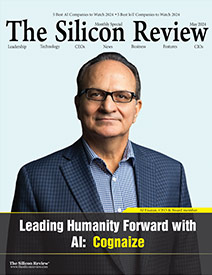50 Most Admired Companies of the Year 2022
Camgian – Developing intelligent software systems powered by big data and artificial intelligence that drive speed and quality of critical decisions
The Silicon Review
![]()
In just under a decade, cognitive computing will become part of our daily lives, and will change large and important fields, such as healthcare, education, business, banking, retail, HR, and many more. In the right hands, humanity will benefit from this new technological innovation. It’s not so hard to believe. Concepts like automation, machine learning, and artificial intelligence sounded strange before they were invented and applied to modern problems. Today, these technologies improve our lives at home and at work for the better, powering technologies like handwriting recognition, facial identification and behavioral pattern determination to any task requiring cognitive skills. Cognitive computing allows computers to mimic the way the human brain works. Cognitive computing uses self-learning algorithms based on data mining and pattern recognition to generate solutions to a wide variety of problems.
Camgian is a recognized leader in developing advanced sensing and information technologies that deliver real-time, actionable intelligence. Leveraging innovations in the areas of software, artificial intelligence and edge computing, Camgian Cognitive Computing services are built on a novel technology platform that accelerates the application of AI and machine learning algorithms for a wide range of business needs.
Why Camgian
People & Process That Deliver Automation: Agile teams of Camgian data scientists, AI engineers, and software developers leverage proprietary platform technologies along with client and 3rd party data resources to efficiently deliver production-ready decision models that drive automation, productivity, and scale. Delivery can take the form of raw data, reports, or containerized models, which can be deployed on-premises or hosted remotely as a cloud service. Camgian’s production process includes rigorous testing, optimization, and quality assurance to ensure that model performance meets client business and operational objectives. Upon deployment, support services include ongoing model upgrades and maintenance that drive continued performance improvements based on operational feedback and new data creation.
Engagement Made Efficient, Easy & Productive Data Engineering: The client engagement process begins with an on-site executive briefing, which provides an overview of Camgian’s Cognitive Computing Services, and the identification of a high-priority client case study. Next, technical diligence is conducted by Camgian personnel to evaluate the feasibility of developing a robust machine learning model based on sample data provided by the client. Results of the diligence effort are provided to the client and if determined feasible, a proposed plan to develop and demonstrate an integrated data platform (IDP) and model prototype(s) are included as deliverables. Camgian leverages an agile development process which includes sprints comprising short design and development cycles. Stand-up meetings with client personnel are conducted at frequent intervals to review both the results of the previous sprint and acquire feedback on the design of the next sprint cycle. This agile development approach and close client engagement ensure that operational needs and objectives are continuously reviewed and integrated into the overall development program.
Cognitive Computing Made Simple with Robust Product Suite
Prowl: is a low-power, compact radar system that provides long-endurance, persistent target detection and tracking in harsh operational environments. Designed for special operations, Prowl supports rapid deployment in any configuration. The high update rate and high probability of detection combined with its low Size, Weight, and Power (SWAP) make it the perfect “bolt-on” solution to fill existing capability gaps in currently deployed stand-alone or networked end-to-end systems. Prowl’s small, lightweight man-packable form factor and easy set-up enables transportation and deployment in austere locations. Prowl’s low-power consumption enables unattended, long battery life operations of several months. Command and Control (C2) is provided through RaptorX or ATAK user interfaces that support deployment on both laptop and hand-held devices wirelessly connected to the Prowl radar unit.
ProwlCAM: is a low-power, smart imaging capability for the Prowl Unattended Ground Sensor (UGS) system. ProwlCAM addresses a critical need for augmenting Prowl radar tracks with visual target confirmation. Designed as a “bolt-on” capability to the Prowl radar, ProwlCAM includes computer vision algorithms that deliver robust, high-resolution target imagery to the end-user C2 device. ProwlCAM co-mounts to the Prowl radar, connecting with just one cable, which simplifies set-up and provides increased geo-registration accuracy as compared to traditional UGS/camera configurations set-up. ProwlCAM supports both day and night operations through its combination of high megapixel visible spectrum (EO) and long-wave infrared (LWIR) cameras that capture images of Prowl radar targets within the camera’s field of view and displays them to the warfighter to enable more informed decisions regarding potential threats and their activities. ProwlCAM supports long field life by operating at very low power- only “waking up” when triggered by the Prowl radar
Gary Butler | Founder, Chairman, and CEO
Gary Butler has spent two decades working in the field of algorithm development and signal processing. During his career, he has led numerous DARPA and other government-funded programs to build next-generation intelligence, surveillance and recognizance (ISR) capabilities for the US military. Dr. Butler’s expertise is in the area of signal processing with a concentration in feature extraction algorithms and artificial intelligence (AI) based classification systems. His work in the field includes the invention of a novel neural network classification method that leverages genetic programming to intelligently adapt and retrain neural networks when operating in dynamic environmental conditions.
Dr. Butler earned his Ph.D. from the University of Cambridge in engineering where he was a member of Churchill College and studied the modeling of non-linear dynamic systems and the application of wavelets to signal analysis. At Cambridge, he collaborated with Professor David Newland, Head of Department for Cambridge Engineering and Fellow of the Royal Academy of Engineering, on the advancement of wavelet theory for improving the spectra analysis of complex transient signals generated from nonlinear dynamic systems.









